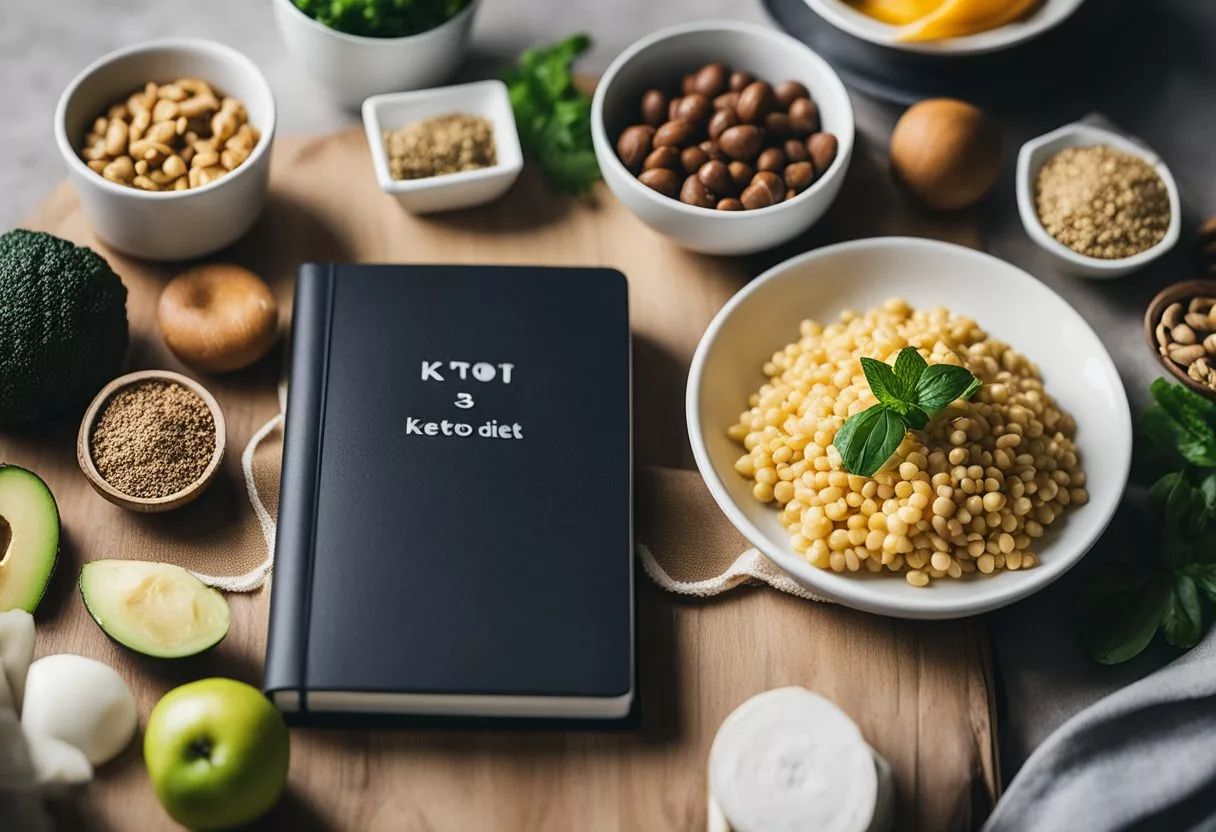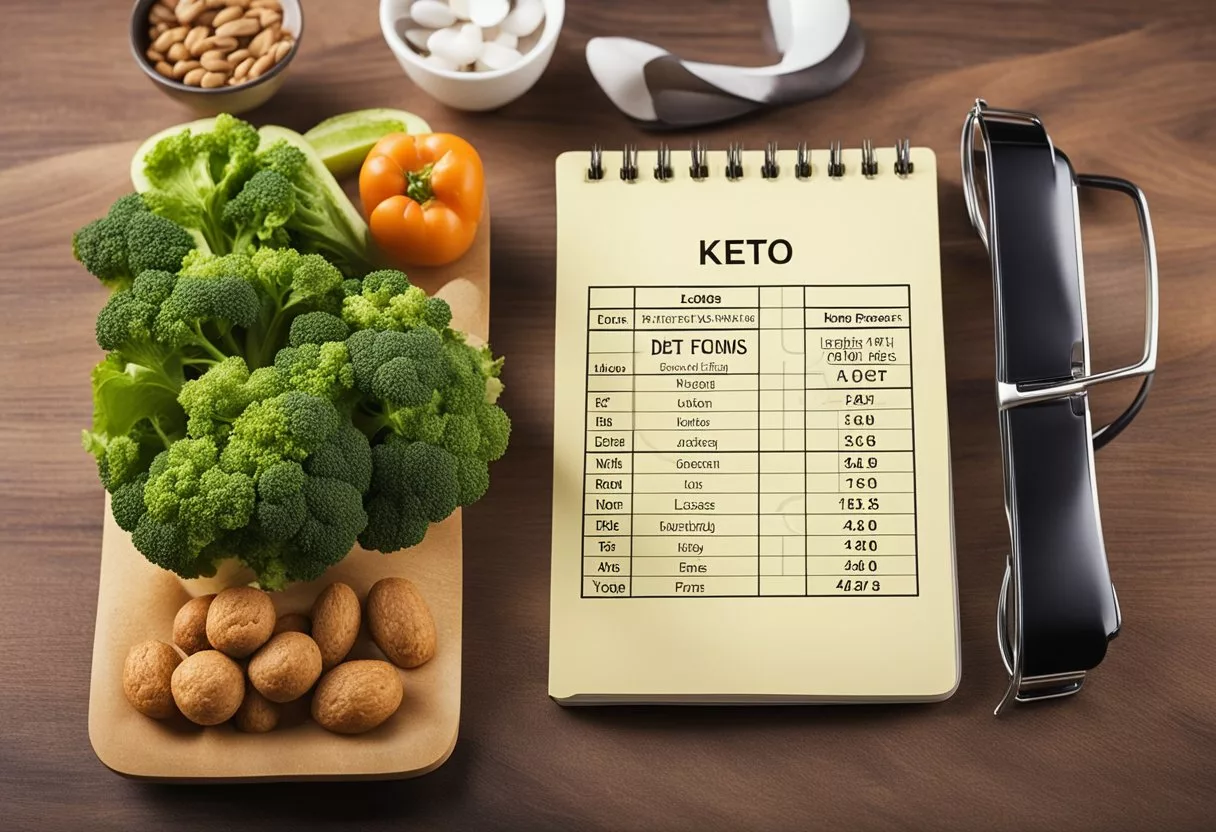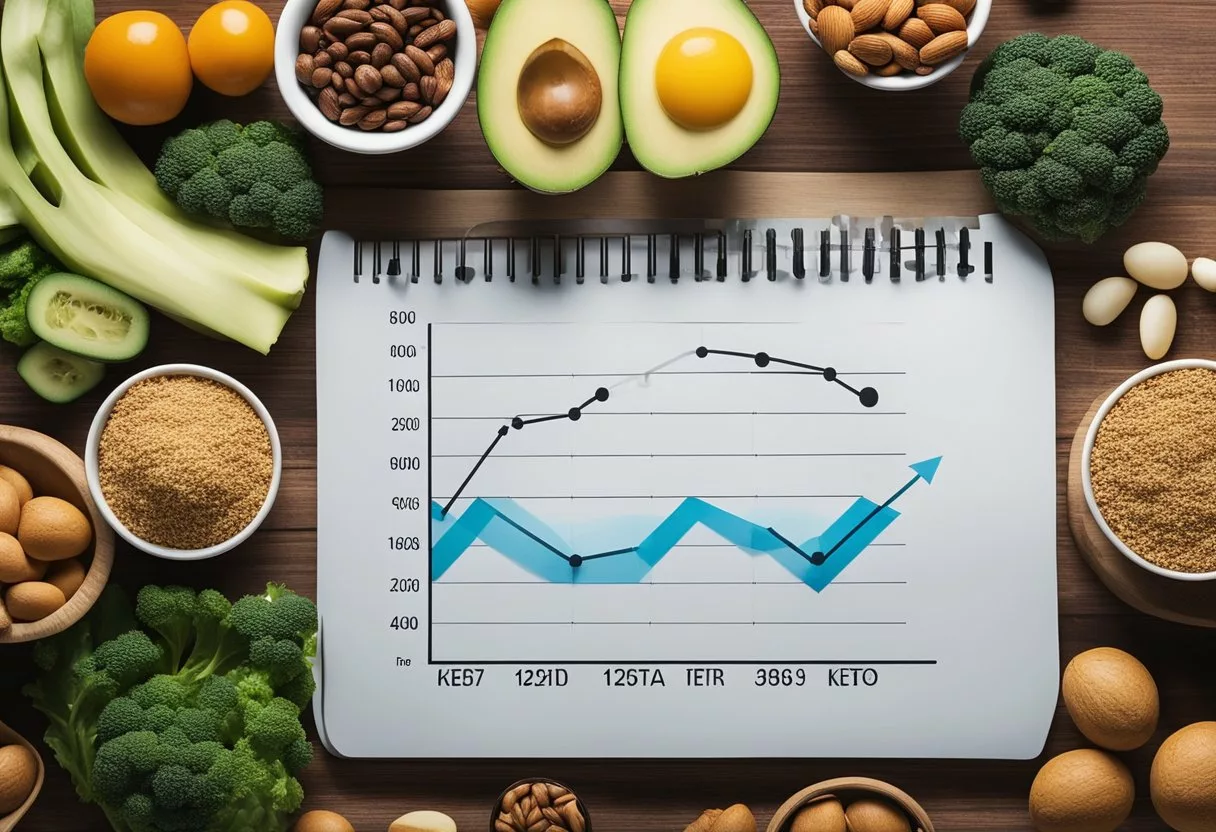The ketogenic diet, commonly referred to as keto, is a high-fat, low-carbohydrate diet that has gained popularity for its potential to facilitate weight loss and improve health markers such as blood sugar control. The diet aims to induce a metabolic state known as ketosis, where the body becomes exceptionally efficient at burning fat for energy.
Tracking progress on the keto diet isn’t limited to just monitoring weight loss. It encompasses several methods to assess changes in body composition, dietary adherence, and overall well-being.

Key factors in tracking progress include body measurements, dietary journals, and specific health markers. As individuals embark on their keto journey, taking before and after photos together with body scans or body-fat testing at regular intervals may provide visual and quantitative evidence of change.
Keeping a journal to record daily food intake, macronutrient ratios, and personal reflections is another cornerstone in gauging how well one adheres to the ketogenic regimen. It is integral for individuals to understand how these measures reflect the efficacy of the diet and inform adjustments for continued improvement.
With technology at their fingertips, individuals can now utilize various applications designed for the keto diet. These apps often offer features like carb tracking, recipes, macronutrient balancing, and community support.
The purpose of these resources is to simplify the process of following the ketogenic diet, making it easier to maintain consistency and achieve desired health outcomes. When used effectively, they can be a powerful tool for anyone looking to maximize their keto diet efforts.
Setting Your Keto Goals

When individuals embark on a ketogenic diet, goal setting is a crucial step. It provides a roadmap and a source of motivation. Goals should be specific, measurable, achievable, relevant, and time-bound (SMART).
- Specific: They should decide how many pounds they wish to lose.
- Measurable: This can be tracked using scales and body measurements.
- Achievable: The target should be realistic, reflecting safe and sustainable weight loss.
- Relevant: Weight loss goals should align with their broader health aspirations.
- Time-bound: They need to set a deadline to create urgency.
Health Goals: Besides weight loss, individuals may aim to enhance overall wellness through the keto diet. This includes:
- Improving blood sugar levels
- Reducing blood pressure
- Enhancing mental clarity
To track these aspects, they might consider metrics like:
| Health Metric | Tracking Method |
|---|---|
| Blood Sugar Levels | Regular blood glucose monitoring |
| Blood Pressure | Periodic measurements with a sphygmomanometer |
| Mental Clarity | Self-assessments or cognitive evaluations |
Lastly, they should regularly revisit and, if necessary, adjust their goals to ensure they remain aligned with their health and weight loss journey. This dynamic approach allows for a tailored keto experience, catering to individual needs and progress rates.
Understanding the Keto Diet

The ketogenic (keto) diet is a low-carb, high-fat approach that aims to initiate a metabolic state called ketosis. In this section, readers will learn about the balance of macronutrients for ketosis, the role and calculation of net carbs, and the importance of incorporating healthy fats for sustaining a keto diet.
Macronutrients and Ketosis
The keto diet revolves around macronutrient ratios tailored to promote ketosis, a metabolic state in which the body burns fat for fuel instead of glucose. Macronutrients on keto typically consist of:
- Protein: Moderate intake to maintain muscle mass.
- Fat: High intake to serve as the primary energy source, usually 70-80% of daily calories.
- Carbohydrates: Strictly limited to typically 5-10% of daily calories to deplete glucose reserves and stimulate ketosis.
The Role of Carbs and Net Carbs
On the keto diet, total carbohydrate intake is drastically reduced. Net carbs are crucial here; they are calculated by subtracting dietary fiber and sugar alcohols from total carbs. Net carbs are considered because fiber isn’t digested and thus doesn’t raise blood sugar levels, which is essential for maintaining ketosis. Dieters often limit net carb intake to 20-50 grams per day.
Importance of Healthy Fats
Healthy fats are the cornerstone of a successful keto diet, replacing the majority of cut carbohydrates. It’s important for individuals to select sources rich in unsaturated fats and omega-3 fatty acids, such as:
- Avocados
- Nuts and seeds
- Olive oil
- Fatty fish like salmon and sardines
Saturated fats like coconut oil and butter are also included, albeit with a recommendation to consume them in moderation to support overall health.
Tracking Your Daily Intake

Careful tracking of daily food intake is a cornerstone for success on the ketogenic diet. Tracking ensures one adheres to the right balance of macronutrients, particularly carbohydrates, to maintain ketosis. The process can be made simpler through the use of food diaries, detailed meal planning, and understanding food labels thoroughly.
Using a Food Diary
A food diary acts as a critical tool for individuals on a keto diet. It enables them to document every meal consumed throughout the day and holds them accountable. Digital solutions like MyFitnessPal, Carb Manager, and Cronometer offer extensive food databases and features like a barcode scanner to ease the tracking process. Users can log in specifics of their dietary intake, tracking up to 21 different nutrients. This detailed tracking helps in identifying and rectifying any dietary slip-ups promptly.
Meal Planning and Grocery Lists
Creating a meal plan and corresponding grocery lists are strategic steps in maintaining a ketogenic lifestyle. A well-thought-out meal plan not only prevents impulsive eating but also streamlines the shopping experience. By translating meal plans into precise grocery lists, individuals ensure they purchase only necessary items that align with their macronutrient goals, effectively minimizing the risk of carb-heavy impulse buys.
Understanding Food Labels
Comprehension of food labels is fundamental in tracking and adhering to a ketogenic diet. Each label provides vital information on the macronutrient content, helping users make informed choices. It’s crucial to recognize that serving sizes may be smaller than expected, which could inadvertently lead to overconsumption of carbohydrates. Individuals should read labels carefully to manage portion sizes accurately and stay within their daily carb allotment.
Monitoring Keto Progress

Accurately monitoring progress on a ketogenic diet involves more than just stepping on a scale. It comprises measuring ketone levels, assessing changes in body composition, as well as evaluating energy levels and mental clarity. Each aspect provides insight into the efficacy of the diet and can inform necessary adjustments.
Tracking Ketone Levels
Ketone levels are a primary indicator of ketosis, the metabolic state where the body burns fat for fuel. Individuals can track these levels through blood ketone meters, urine strips, or breath analyzers.
- Blood Ketone Meters: Offer precise readings but require a blood sample.
- Urine Strips: Less invasive but can become less accurate over time.
- Breath Analyzers: Non-invasive and reusable, though initial investment is higher.
Measuring Weight and Body Composition
While weight on the scale offers some information, body composition provides a more complete picture of progress. Individuals should consider regular measurements of body fat percentage and lean muscle mass.
- Weigh Yourself: Limited to overall body weight changes.
- Body Measurements: Use a tape measure to record circumferences of various body parts.
- Body Composition Scales: Can estimate fat and lean mass through bioelectrical impedance.
Observing Energy Levels and Mental Clarity
The ketogenic diet can lead to enhanced energy and improved mental clarity. Documenting these subjective experiences alongside objective measures can be enlightening.
- Individuals may note fluctuations in energy throughout the day.
- Mental Clarity: Diarizing cognitive changes can help understand the diet’s impact on brain function.
Using Technology to Enhance Your Keto Journey
Incorporating technology into a ketogenic lifestyle can streamline the tracking of dietary intake and fitness activities, connect users with health tracking devices, and foster support within the keto community.
Diet and Fitness Tracker Apps
Modern diet and fitness tracker apps serve as pivotal tools in managing a ketogenic diet. These apps simplify the logging of meals, including keto recipes, and help users maintain a close watch on their macros (macronutrients). For instance, the KetoDiet app is a comprehensive platform that not only tracks macronutrient intake but also offers a database of keto-friendly recipes and a grocery list feature. Similarly, apps like Cronometer aid in macro tracking and visualizing progress with detailed charts, ensuring individuals stay within their desired ketodiet parameters.
| Keto Tracker Features | Purpose |
|---|---|
| Macro Tracking | To manage macronutrient goals |
| Calorie Counter | To monitor daily calorie intake |
| Activity Log | To record workouts and activity |
Integrating with Health Devices
The integration between fitness trackers like Fitbit and Google Fit and ketogenic apps empowers users to sync their activity metrics and workouts directly with their diet records. Wearables automatically record physical activities and exercise, providing insights into how these factors influence one’s ketosis state. Utilizing this information, keto participants can fine-tune their daily macros and workouts to optimize their keto program for better results.
Leveraging Community Support
Community support plays a vital role in the success of a keto program. Many keto apps host forums and social platforms where individuals can share experiences, offer encouragement, and exchange advice. The sense of belonging and shared purpose within these communities provides motivation and accountability. Additionally, some apps facilitate challenges and allow users to celebrate milestones, further harnessing the strength of community to motivate adherence to one’s keto lifestyle.
Adjusting Your Keto Lifestyle
Adapting to a ketogenic lifestyle means making informed decisions about meal planning, handling cravings responsibly, and integrating workouts in a way that supports your goals. This section provides specific strategies to adjust the keto lifestyle for long-term success.
Adapting Meal Plans for Food Preferences
Individual food preferences and special dietary needs like allergies drive the customization of keto meal plans. One must account for these preferences by exploring a variety of keto recipes that are both satiating and enjoyable. For instance, individuals with an allergy to almonds might choose coconut flour as an alternative in their recipes. Those practicing intermittent fasting may adjust their eating windows to ensure they’re getting the necessary nutrients within their specific time frames.
- Suggestions for incorporating personal food preferences into meal plans:
- Substitute nuts or dairy for allergen-friendly seeds or lactose-free alternatives.
- Personalize macros to fit unique dietary requirements while staying in ketosis.
Dealing with Cravings and Cheat Days
Managing cravings is a critical aspect of maintaining a keto lifestyle. It’s natural for one to experience the desire for high-carb foods; however, indulging in cheat days can drastically impact one’s progress. Instead, one might use keto-friendly substitutes to satisfy cravings or employ behavioral strategies such as drinking water or engaging in a distracting activity. Tips to curb cravings include:
- Keep keto-friendly snacks on hand, like cheese or olives.
- Understand and prepare for emotional triggers that might lead to cravings.
Accommodating Exercise and Workouts
Exercise should be a regular component of one’s keto lifestyle, complementing the dietary aspects of the regimen. Individuals may require different approaches to their workouts based on their energy levels and performance goals. It is essential to:
- Stay hydrated and properly fueled, especially before and after exercise.
- Consider meal plans around workout times to ensure optimal energy levels.
Key points to remember when incorporating workouts into a keto lifestyle:
- Hydration: Water intake is vital to compensate for fluid loss.
- Electrolytes: Keto-friendly sources like avocados or leafy greens help replenish minerals lost during sweating.
Overcoming Challenges in Keto
Adapting to a ketogenic lifestyle can lead to substantial health and wellness benefits, but it comes with its own set of challenges. Key areas such as managing blood sugar levels, social situations, and maintaining motivation are crucial for sustained success on this low-carb, high-fat diet.
Managing Blood Sugar and Insulin Levels
On a ketogenic diet, stabilizing blood sugar and insulin levels is paramount. Blood sugar, or blood glucose, is affected by food intake, especially carbohydrates. To maintain ketosis, individuals focus on low-glycemic load foods. Vegetables like leafy greens, avocados, and nuts are staples, as they offer necessary nutrients with low carb counts. Testing fasting blood sugar regularly can help monitor and manage levels effectively, reducing the risk of pre-diabetes and ensuring consistent energy levels throughout the day.
Handling Social and Dining Out Situations
Social encounters and dining out can pose a challenge for individuals following ketogenic eating principles. When in these situations, strategic planning is beneficial. Those on a ketogenic diet can opt for foods that align with their dietary needs by prioritizing dishes rich in proteins and fats while avoiding high-carbohydrate options. Communicating dietary preferences when dining out and suggesting restaurants that offer keto-friendly choices can help maintain adherence to the diet.
Staying Motivated and Consistent
Consistency is the backbone of any dietary plan, and the ketogenic diet is no exception. Staying motivated over the long term requires setting realistic goals and acknowledging the incremental progress made. This might include celebrating non-scale victories, like improved energy levels or a better fit of clothing. Joining keto community groups can offer support and shared experiences that encourage persistence, making the journey toward health and wellness less isolating.
Measuring Success Beyond the Scale
Success on a ketogenic diet involves more than just the numbers on a scale. It consists of a spectrum of improvements ranging from physical changes to improvements in well-being and longevity, each playing a critical role in the pursuit of health goals.
Non-Scale Victories
Non-scale victories (NSVs) are qualitative measures of progress that reflect changes in one’s body and lifestyle. Examples include:
- Clothing Fit: Clothes may fit better or become looser, indicating body composition changes.
- Energy Levels: An increase in energy, often reported by individuals on a keto diet.
These victories are personal and celebrate milestones beyond weight, such as increased physical stamina or receiving compliments on one’s appearance.
Improving Sleep and Reducing Stress
Quality sleep and reduced stress are significant factors in overall health and achieving one’s health goals.
- Sleep Quality: A ketogenic lifestyle may lead to improved sleep patterns, as individuals may experience deeper and more restful sleep.
- Stress: Many individuals report a reduction in stress levels, possibly due to the stabilizing effect of keto on blood sugar levels, which can influence mood and stress.
Engaging with a sleep coach could offer personalized strategies to further enhance sleep quality.
Enhancing Overall Health and Longevity
The ketogenic diet’s impact can extend to long-term health and longevity.
- Longevity: Research suggests that ketosis may impact longevity through various mechanisms, such as reducing inflammation.
- Health Goals: Beyond weight loss, people often experience improvements in biomarkers like blood glucose control and blood pressure, aligning with broader health goals.
In summary, tracking progress on keto is most effective when considering a wide range of indicators — from non-scale victories and sleep improvements to the pursuit of long-term health and vitality.
Resources and Support Systems
Navigating the ketogenic diet can be complex, and having access to a reliable support system and effective tools can greatly enhance a dieter’s experience and results. From educational materials to sophisticated tracking apps, and experienced coaching, these resources are designed to support keto dieters in achieving their dietary goals.
Educational Keto Resources
For those beginning their keto journey as well as seasoned dieters, educational keto resources are paramount. These encompass a variety of materials, including databases of keto-friendly foods and elaborately designed diet plans. Keto resources may include articles on micronutrient management, comprehensive FAQ sections that address common concerns, and guides can offer substantial support. They help keto dieters understand the principles of the diet, make informed food choices, and stay up-to-date on the latest research and trends.
Navigating Diet Apps and Tools
Diet apps and tools facilitate the tracking of daily food intake, which is essential for remaining within the ketogenic regimen’s macronutrient ratios. Calorie tracking is a key feature of these diet apps, allowing users to log meals and view their eating patterns through charts and graphs. Some apps offer bonuses like barcode scanning for easy food entry, a database of keto-approved foods, and integration with devices that monitor physical activity. By leveraging these tools, keto dieters can track progress, understand nutrient profiles, and tailor their diets to meet specific health goals.
Accessing Expert Advice and Coaching
Keto dieters can take advantage of personalized support by accessing expert advice and coaching services. Coaching may range from one-on-one sessions with nutritionists who specialize in the ketogenic diet to group coaching from a community of fellow keto adherents. These experts typically use blood tests and other assessments to help tailor diet plans to individual needs, providing advice that’s based on deep knowledge of how the body responds to ketogenic diets. For dieters looking for more directed guidance, coaching can make the difference in achieving sustained success on the diet.
Frequently Asked Questions
In this section, readers will find answers to common inquiries about tracking progress on the ketogenic diet, from the basics of food monitoring to the timeframe for expected results.
How can beginners effectively track their food intake on a ketogenic diet?
Beginners can track their food intake by using food diaries or ketogenic diet apps that allow for the logging of daily meals. It is important for them to record all foods and drinks consumed, including portion sizes.
What are the features of the best keto tracking apps available?
The best keto tracking apps include features such as barcode scanning for easy food logging, macronutrient tracking enabling users to see net carbs, fats, and proteins, and progress charts that display weight loss and body measurements.
How do you monitor your state of ketosis to ensure you remain on track?
Individuals can monitor their state of ketosis through urine test strips, breath analyzers, or blood ketone meters. Consistent testing can help ensure they remain in ketosis.
What are the key dietary components to monitor when following a keto diet?
On a keto diet, it is vital to monitor carbohydrate intake to stay below a certain threshold, usually 20-50 grams per day, while focusing on high-fat and moderate protein foods that support ketosis.
How long does it typically take to see results after starting a ketogenic diet?
Results can vary by individual, but many people report observable weight loss and improved energy levels within the first few weeks of starting a ketogenic diet. Full ketosis can be achieved in as little as 2-7 days.
What are some low-carb appetizer options that align with ketogenic dietary guidelines?
Some appetizer options suitable for a keto diet include cheese and charcuterie plates, vegetable sticks with guacamole, and stuffed mushrooms. These are low in carbs and align with ketogenic dietary guidelines.